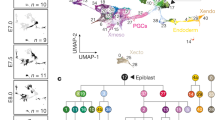Abstract
Among the most important histone methyltransferases for metazoan development are EZH1/2 and their homologs, which methylate histone H3 lysine 27 and act as part of a highly conserved set of chromatin regulators called Polycomb Group (PcG) proteins. Reaching a precise understanding of the roles of PcG proteins in the orchestration of differentiation and the maintenance of cell identity requires a variety of genetic and molecular approaches. Here, we present a full suite of methods for the study of PcG proteins in early murine development, including mutant strain generation, embryonic stem cell derivation, epigenomic profiling, and immunofluorescence and in situ hybridization.
Access this chapter
Tax calculation will be finalised at checkout
Purchases are for personal use only
Similar content being viewed by others
References
Lewis EB (1978) A gene complex controlling segmentation in Drosophila. Nature 276:565–570
Pirrotta V, Rastelli L (1994) White gene expression, repressive chromatin domains and homeotic gene regulation in Drosophila. Bioessays 16:549–556
Boyer LA, Plath K, Zeitlinger J et al (2006) Polycomb complexes repress developmental regulators in murine embryonic stem cells. Nature 441:349–353
Almeida M, Pintacuda G, Masui O et al (2017) PCGF3/5-PRC1 initiates Polycomb recruitment in X chromosome inactivation. Science 356:1081–1084
Yakushiji-Kaminatsui N, Kondo T, Hironaka K-I et al (2018) Variant PRC1 competes with retinoic acid-related signals to repress Meis2 in the mouse distal forelimb bud. Development 145:dev166348
Morey L, Santanach A, Blanco E et al (2015) Polycomb regulates mesoderm cell fate-specification in embryonic stem cells through activation and repression mechanisms. Cell Stem Cell 17:300–315
Iwama A, Oguro H, Negishi M et al (2004) Enhanced self-renewal of hematopoietic stem cells mediated by the polycomb gene product Bmi-1. Immunity 21:843–851
Ezhkova E, Pasolli HA, Parker JS et al (2009) Ezh2 orchestrates gene expression for the stepwise differentiation of tissue-specific stem cells. Cell 136:1122–1135
Chiacchiera F, Rossi A, Jammula S et al (2016) Polycomb complex PRC1 preserves intestinal stem cell identity by sustaining Wnt/β-catenin transcriptional activity. Cell Stem Cell 18:91–103
Cao R, Wang L, Wang H et al (2002) Role of histone H3 lysine 27 methylation in Polycomb-group silencing. Science 298:1039–1043
Fischle W, Wang Y, Jacobs SA et al (2003) Molecular basis for the discrimination of repressive methyl-lysine marks in histone H3 by Polycomb and HP1 chromodomains. Genes Dev 17:1870–1881
Wang H, Wang L, Erdjument-Bromage H et al (2004) Role of histone H2A ubiquitination in Polycomb silencing. Nature 431:873–878
de Napoles M, Mermoud JE, Wakao R et al (2004) Polycomb group proteins Ring1A/B link ubiquitylation of histone H2A to heritable gene silencing and X inactivation. Dev Cell 7:663–676
Gao Z, Zhang J, Bonasio R et al (2012) PCGF homologs, CBX proteins, and RYBP define functionally distinct PRC1 family complexes. Mol Cell 45:344–356
Tavares L, Dimitrova E, Oxley D et al (2012) RYBP-PRC1 complexes mediate H2A ubiquitylation at polycomb target sites independently of PRC2 and H3K27me3. Cell 148:664–678
Healy E, Mucha M, Glancy E et al (2019) PRC2.1 and PRC2.2 synergize to coordinate H3K27 Trimethylation. Mol Cell 76:437–452.e6
Højfeldt JW, Hedehus L, Laugesen A et al (2019) Non-core subunits of the PRC2 complex are collectively required for its target-site specificity. Mol Cell 76:423–436.e3
Blackledge NP, Farcas AM, Kondo T et al (2014) Variant PRC1 complex-dependent H2A ubiquitylation drives PRC2 recruitment and polycomb domain formation. Cell 157:1445–1459
Fursova NA, Blackledge NP, Nakayama M et al (2019) Synergy between variant PRC1 complexes defines Polycomb-mediated gene repression. Mol Cell 74:1020–1036.e8
Endoh M, Endo TA, Shinga J et al (2017) PCGF6-PRC1 suppresses premature differentiation of mouse embryonic stem cells by regulating germ cell-related genes. Elife 6:e21064
Ying Q-L, Wray J, Nichols J et al (2008) The ground state of embryonic stem cell self-renewal. Nature 453:519–523
Kaya-Okur HS, Wu SJ, Codomo CA et al (2019) CUT&Tag for efficient epigenomic profiling of small samples and single cells. Nat Commun 10:1930
Kaya-Okur HS, Janssens DH, Henikoff JG et al (2020) Efficient low-cost chromatin profiling with CUT&Tag. Nat Protoc 15:3264–3283
Eto H, Kishi Y, Yakushiji-Kaminatsui N et al (2020) The Polycomb group protein Ring1 regulates dorsoventral patterning of the mouse telencephalon. Nat Commun 11:5709
Kondo T, Isono K, Kondo K et al (2014) Polycomb potentiates meis2 activation in midbrain by mediating interaction of the promoter with a tissue-specific enhancer. Dev Cell 28:94–101
Picelli S, Björklund AK, Reinius B et al (2014) Tn5 transposase and tagmentation procedures for massively scaled sequencing projects. Genome Res 24:2033–2040
Buenrostro JD, Wu B, Litzenburger UM et al (2015) Single-cell chromatin accessibility reveals principles of regulatory variation. Nature 523:486–490
Meers MP, Bryson TD, Henikoff JG et al (2019) Improved CUT&RUN chromatin profiling tools. Elife 8:e46314
Acknowledgments
We would like to thank Dr. Hiroki Sugishita for discussion and advice on CUT&Tag modifications. This work was supported by the Japan Agency for Medical Research and Development (AMED-CREST) (13417643 to H.K.), Grant-in-Aid for Scientific Research on Innovative Areas (JP19H05745 to H.K.), JSPS KAKENHI (JP19K22695, JP21K09784 to N.Y.-K.), and Takeda Science Foundation (to N.Y.-K.).
Author information
Authors and Affiliations
Corresponding authors
Editor information
Editors and Affiliations
Rights and permissions
Copyright information
© 2022 The Author(s), under exclusive license to Springer Science+Business Media, LLC, part of Springer Nature
About this protocol
Cite this protocol
Yakushiji-Kaminatsui, N., Kondo, T., Ohinata, Y., Takano, J., Koseki, H. (2022). Genetic, Genomic, and Imaging Approaches to Dissect the Role of Polycomb Group Epigenetic Regulators in Mice. In: Margueron, R., Holoch, D. (eds) Histone Methyltransferases. Methods in Molecular Biology, vol 2529. Humana, New York, NY. https://doi.org/10.1007/978-1-0716-2481-4_10
Download citation
DOI: https://doi.org/10.1007/978-1-0716-2481-4_10
Published:
Publisher Name: Humana, New York, NY
Print ISBN: 978-1-0716-2480-7
Online ISBN: 978-1-0716-2481-4
eBook Packages: Springer Protocols




